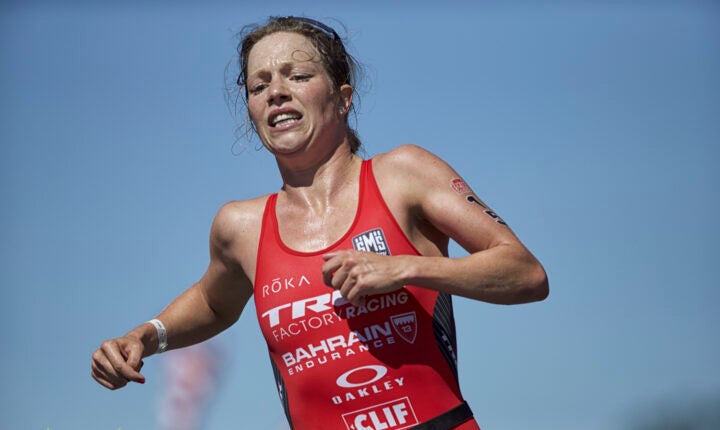[ad_1]
“], “filter”: { “nextExceptions”: “img, blockquote, div”, “nextContainsExceptions”: “img, blockquote”} }”>
This past weekend, Ironman California was canceled just 45 minutes before the race’s start due to a bomb cyclone that barreled down on northern California, bringing windy and rainy conditions deemed too unsafe to compete in. While weather-related cancelations are rare, Mother Nature has made things messy on many a race day. From frigid water temps to sizzling heat, here’s a look back at five races held in extreme conditions and downright wacky weather—and how organizers and athletes handled what was thrown their way.
RELATED: Hotter, Harder, And More Expensive: Why Triathletes Should Care About Climate Change
Ironman China and 70.3, Hainan Island, China
The Date: April 19, 2009
The Weather: Extremely hot and humid. At race start time, the thermometer read 90 degrees F with 85% humidity, and only continued to climb throughout the day, eventually topping 110 degrees F.
The Outcome: With the high heat and very little shade on course, athletes suffered in the first-ever Ironman-branded race in China. “The heat was unbelievable. I cannot describe it,” eventual 70.3 champ Chris McCormack recalled on his blog. “I was watching ambulance after ambulance on the course putting Ironman competitors, who could not get through the bike course and were collapsing, into the back of them. It was like a war zone.” McCormack, who went on to say the race was, “without question the toughest event” he had ever done, noted that winner Rasmus Henning posted what was the slowest split by a winner of any Ironman (3:38:22). By the following year, race organizers decided to push the event back to early March in the hopes of decreasing the chance of a hot race day.
Ironman Lake Tahoe, Kings Beach, California

The Date: Sept. 22, 2013
The Weather: With temperatures hovering around 30 degrees F on race morning and not rising much more throughout the day, Lake Tahoe remains one of the coldest Ironmans on record. And after a snow storm rolled through the area the day before the race, bundled-up athletes found themselves chipping away at icicles on their bike in the transition area.
The Outcome: After exiting the relatively balmy water (temps read 61 degrees F the morning of) into the freezing air, many athletes struggled to get and stay warm on the bike. A total of 267 athletes–12 percent of the field–either dropped out during the bike portion of the race or did not make the cut-off. The run continued to be a race of attrition, with another 182 athletes calling it a day. All told, some 21% of the field did not finish the race, and the 2013 field’s average finish time of 14 hours and 6 minutes, remains among the highest in Ironman’s history. (The next year’s race was canceled because of a large fire and smoke in the area.)
Ironman Texas, The Woodlands, Texas
(Credit: David Welby)
The Date: May 14, 2016
The Weather: Although the day began warm but otherwise fairly benign, some nine hours into the race, a thunderstorm rolled in, ultimately dropping the temperature from 90 degrees F to 68 degrees F in an hour and sending t rain, pea-sized hail, 20 mph wind gusts, and bolts of lightning down on the course.
The Outcome: During the storm, race officials corralled all remaining competitors and brought them into parking garages, under porches, or had them huddle beneath overpasses until the weather passed. It took up to 48 minutes to do just that, at which point the athletes were allowed to return to the run and finish out their race. (In an effort to be as fair as possible, race officials based the age-group awards and slots for Kona on standings from the timing mats they crossed prior to the storm.)
Auckland World Triathlon Grand Final, New Zealand
The Date: Oct. 20-22, 2012
The Weather: Cold, driving rain was the theme of the championship weekend, with the torrential downpours wreaking havoc on several high-stakes races, from the elites to the juniors. There was enough carnage for the World Triathlon to put together a montage of wrecks on the hilly and twisting bike course, showing just how slick and dangerous the conditions were (the run was less dangerous, but athletes still slipped on the wet roads). In the elite events, most of the race favorites managed to remain rubber side down, with Spain’s Javier Gomez outsprinting Great Britain’s Jonny Brownlee by two seconds to take the men’s race. (The day prior, Germany’s Anne Haug crossed some 12 seconds before U.S.A.’s Gwen Jorgensen to take the title.)
Escape from Alcatraz Triathlon, San Francisco, California

The Date: June 11, 2017
The Weather: High winds from a chaotic spring weather system churned the bay into an unrelenting chop, creating conditions too dangerous for small watercraft, including rescue kayaks.
The Outcome: Minutes before the race was set to go off, race director Bill Burke got on a bullhorn and informed 2,000 athletes that they would have to disembark the ferry they were preparing to leap off of to swim from Alcatraz Island, take a bus back to transition, and compete in a bike-run race instead. It was the first time in the race’s 37-year-history that the “escape” itself would be canceled.
[ad_2]
Source link

